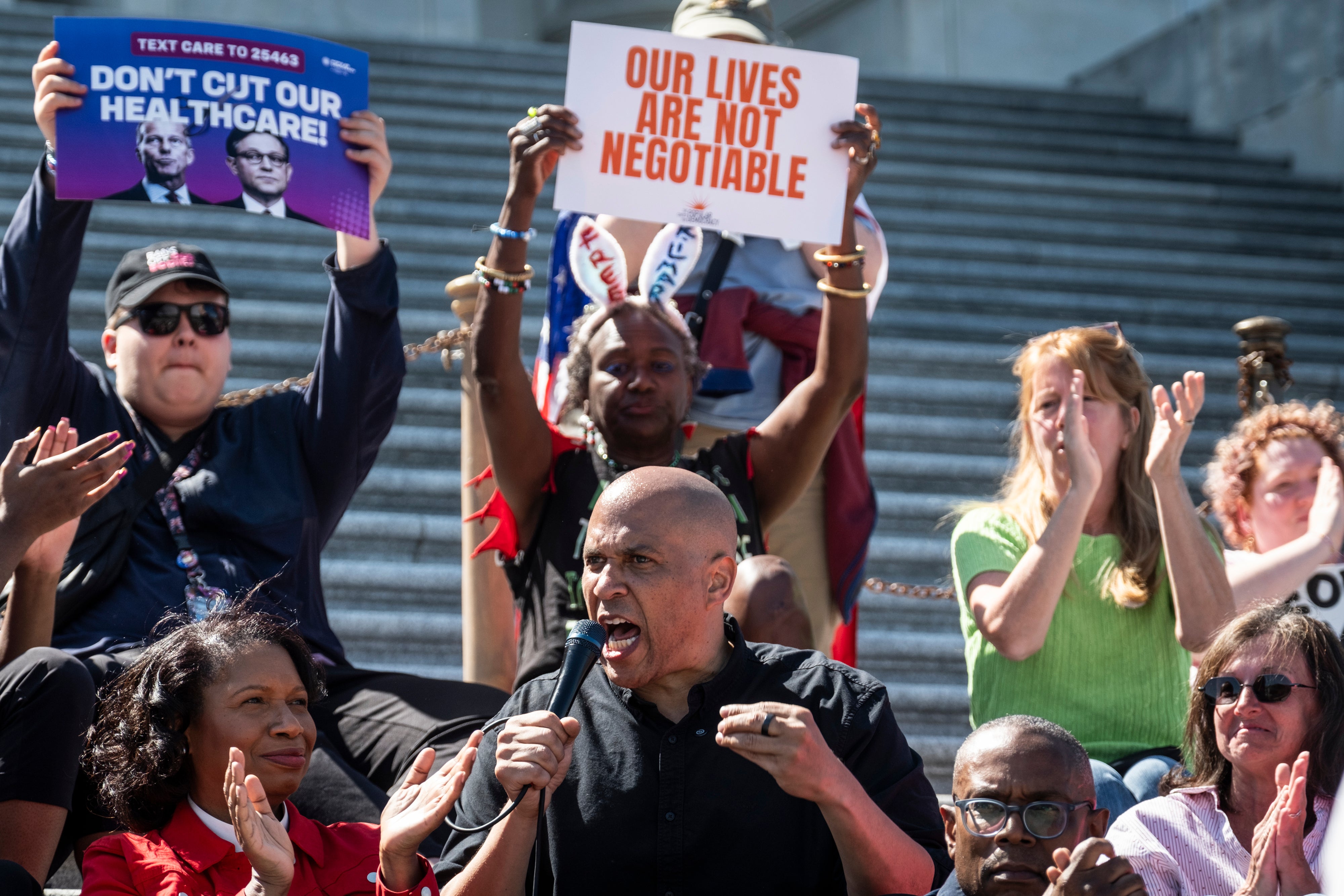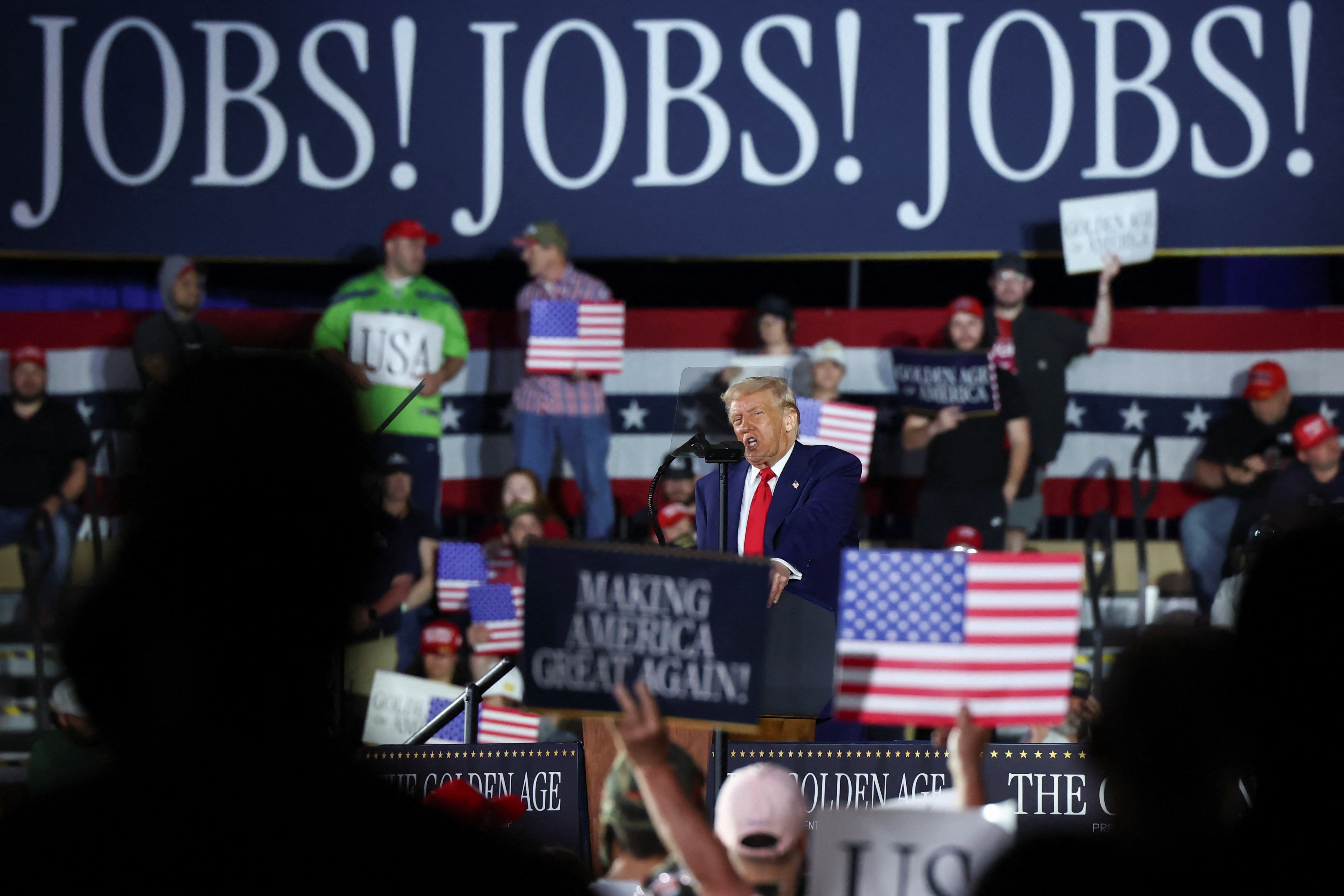How Trump fast-tracked Project 2025 and why it’s worse than you think
To understand the 100-day sprint, you have to understand the long game that’s playing out behind the scenes, says Alex Hannaford. Now it is happening in real time, America is having to face up to the consequences of a new dictator class

No one can accuse Donald Trump of easing his way slowly into the job the second time around; of slouching back in his chair in the Oval Office, Fox News on the big screen, remote in hand. In 100 days he’s managed to lay off 12,000 federal workers in the name of government efficiency, alienate countless allies, threatened to invade Greenland and take over the Panama Canal, humiliated Volodymyr Zelensky, told Canada he wants to see it become the 51st state (prompting a historic win for Mark Carney) and imposed tariffs on Europe and elsewhere that signal an end to free trade.
But perhaps most notable in terms of his policy agenda is that he has essentially governed by executive order – more than 140 of which have bypassed Congress entirely. And these orders have targeted everything from immigration to education to the detention of 6 January defendants. All in under four months.
Why anyone is surprised, however, is the question. In Project 2025, the sweeping, dystopian blueprint for his second term crafted by The Heritage Foundation, he was presented with the instruction manual of how to govern. While on the campaign trail, he disavowed it, saying: “I haven’t read it, I don’t want to read it.”
But from day one, it feels as if his administration has been following the right-wing plan to disrupt and tear down key government infrastructure. They have set about erasing federal language around gender identity and reproductive health, targeted DEI (diversity, equity and inclusion) initiatives, dismantled climate policies, and have been busy stacking the bureaucracy with loyalists. It is clear to anyone following American politics, Project 2025 is not theoretical anymore – it’s happening in real time. And it’s gone further than any of the architects of Project 2025 surely ever imagined.
Legal challenges have swelled, too, with the administration accused of sidestepping court orders, including a Supreme Court mandate to return a wrongfully deported migrant. The White House, meanwhile, insists it’s reclaiming power from what it views as an entrenched, unelected judicial bureaucracy. A key check and balance put in by the founding fathers to protect democracy from segueing into an autocracy.
Meanwhile, the religious undercurrent of the document is hiding in plain sight too. Government agencies have ramped up enforcement, launching initiatives with culture war missions like targeting “anti-Christian bias”, and task forces that have raided clubs looking for immigrants to deport.
This was the dream scenario sketched out in “Mandate for Leadership”, the 900-page document that serves as the ideological spine of Project 2025. But Trump hasn’t just followed its recommendations – he’s outpaced them. He handed Elon Musk the keys to the federal government and shuttered the United States Agency for International Development, triggering lawsuits from federal employee unions and mass protests.
David Cay Johnston, a Pulitzer Prize-winning investigative journalist and author of The Making of Donald Trump and It’s Even Worse Than You Think: What the Trump Administration is Doing to America says that his second book, which was published during Trump’s first administration, showed that they set out to destroy the federal government – an endeavour they’re continuing in his second.
“Steve Bannon said they were going to deconstruct the administrative state. And in a few places, where he had competent or zealous managers, they did. They damaged the Environmental Protection Agency. But in most cases, they had little to no success because Donald doesn’t know what he’s doing.”

Now though, Johnston, who is currently a professor at Rochester Institute of Technology in New York, says Trump has become more successful because he is surrounded by people who have dreamed of dismantling the government for years. “And they are now his attack team.”
A year ago, New York Times opinion columnist Carlos Lozada said “Mandate for Leadership” called “for a relentless politicising of the federal government, with presidential appointees overpowering career officials at every turn and agencies and offices abolished on overtly ideological grounds.”
Back in February, in a piece for The Independent, I wrote: “Some of the verbiage in that document is eye-opening.” That in its pages it states, “America’s vast reserves of oil and natural gas are not an environmental problem; they are the lifeblood of economic growth”; that “conservatives should gratefully celebrate the greatest pro-family win in a generation: overturning Roe v Wade, a decision that for five decades made a mockery of our Constitution and facilitated the deaths of tens of millions of unborn children.” And “the National Oceanic and Atmospheric Administration, which houses the National Weather Service … and other components [have] become one of the main drivers of the climate change alarm industry and, as such, is harmful to future US prosperity”.

Project 2025 also argued that the president should have absolute authority over the executive branch. But the boldness with which the second Trump administration has, in the words of Michele Goodwin, a constitutional law professor at Georgetown Law, issued executive orders “in a way that’s devastating to democracy” has shocked many.
Johnston said the speed and scale of Trump’s bulldozing is unprecedented. “He took the best-performing economy in the world and flushed it. The stock market has dropped significantly, and although it’s popping up and down day-to-day, that’s not a good sign. Unemployment is going to go up. He has turned close allies into sceptics, if not hostile countries. The level of ignorance is appalling.
“Businesses are complaining they don’t have any certainty as to what’s going on. No one is investing. And meanwhile, Donald flip-flops: today there’s a tariff, tomorrow there isn’t a tariff. And President Xi is not blinking.”
Not that any of this is being admitted by Trump himself, of course. Despite the almost daily rollback of his tariff programme, which has directly harmed his Maga allies, at a rally to mark his 100th day in power, he declared: “100 days of greatness.”

Johnston, who has studied Trump’s rise for decades, puts it bluntly: “Trump believes he is our king. He has no idea what’s in the constitution. He’s appallingly ignorant. He thought [19th-century abolitionist] Frederick Douglass was alive, and he thought that Finland was an oblast of Russia.”
But to understand the 100-day sprint, you have to understand the long game. This was always about power consolidation. Steve Bannon once promised they’d “deconstruct the administrative state”. Now, they’re doing it.
But in their quest for control, Johnston believes Trump’s team has overplayed their hand – particularly in targeting Medicaid, the federal health insurance plan which disproportionately supports Trump’s own red-state base.
“You’ll start hearing stories – a working mother whose child is dying because of the cuts they made to Medicaid. Or a single mother saying her husband died because insulin went from $35 to $1,000. That’s stupid because you’re slapping your support base in the face … These people don’t know what they’re doing; they’re just a wrecking crew.”

But with a House and Senate in Republican hands, and so compliant, why hasn’t he bothered asking them to even rubber-stamp those policies? “Because Donald … is our dictator,” Johnston said. “Why would you go to Congress when you think you can just rule by executive order? Part of the scheme [behind governing by] executive order is to put out so many that nobody can keep track of them. I think the thrust of it is ignoring the courts and ignoring the legislative process and basically declaring, ‘My people and I are going to do whatever we want.’”
What Johnston is saying is that there’s no pretence of any compromise. This isn’t policy reform. It’s a regime change. A blitzkrieg of executive action designed to overwhelm institutions before they can push back. And when they do – like the courts have, sporadically – the response is either defiance or circumvention.
The exception? The US Supreme Court.
On 1 July 2024, the court ruled in a 6-3 decision that former presidents are entitled to broad immunity from criminal prosecution for actions taken while in office. Johnston said he wouldn’t be surprised if it directly or indirectly revisits that immunity decision because it can’t live with Trump claiming that he doesn’t have to follow the orders of the courts.

“John Glover Roberts Jr [the chief justice of the United States] is an institutionalist, and he has got to be having trouble sleeping at night because of the nightmare that he realises he created.”
If Trump loses the next election in 2028 – assuming he leaves the White House, which some doubt – and a Democratic president gets the keys, Johnston said he or she could dispense with all Trump’s executive orders en masse. “But Donald’s not worried about that. He isn’t planning to leave. It took Rome 40 years to go from a democracy to a dictatorship. Hitler pulled it off in less than two months. Donald Trump pulled it off in less than one.”
At his 100th-day rally in Michigan, Trump made a direct attack on “communist radical left judges” for trying to seize his power, warning, “nothing will stop me”.
It is a warning, Johnston says, that we should heed: “All the people who are doing Donald Trump’s bidding are putting themselves at very serious risk of criminal prosecution and civil litigation because the immunity decision does not extend to them.
“And if you’re carrying out illegal acts on behalf of Donald Trump, you’re not going to be protected. This also means that they will be very motivated to help subvert or prevent future elections that would put them at risk.”
We’ve now got to wait 1,370 days to find out if that happens.



Join our commenting forum
Join thought-provoking conversations, follow other Independent readers and see their replies
Comments